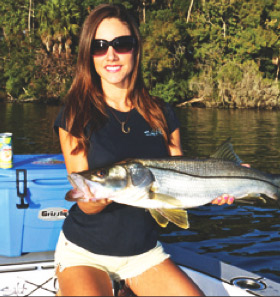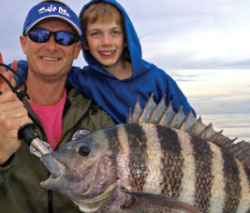“I’ve been a die-hard snook fisherman for as long as I can remember.”
When I was a teenager, back in the 80’s, I would travel over 100 miles just to get the chance to catch snook. Some- times it would be Cape Canaveral and other times it would be Tampa Bay. Either way, this was the only way to get my “snook fix,” until the day I earned my own local stripes. This is a day I will never forget.
I was fishing for bait back in Ozello, along the banks of an old abandoned limerock pit that had been filled in with saltwater, due to its close proximity to the marsh. This pit always held lots of pinfish and mud minnows that we would use for redfish bait in the backcountry. On a bright sunny summer day, I saw what seemed to be logs lying on the bottom of a drop off. I really didn’t think much of it until I saw one of them move. After I turned my focus to those logs, I realize that they were not logs; they were actually snook. Yes snook, all the way up here in Ozello in an old abandoned lime rock pit! Wow, Who would have thought of them being way up here, but there they were right in plain sight. Back then the normal northernmost range on the West coast of Florida for common snook was thought to be Tampa Bay and Anclote Key. Now, you can understand why I was in such amazement when I had discovered that there was a population of snook way up here in the Big Bend.
Since then, there has been much more re- search done on common snook and now their northernmost range is actually closer to Cedar Key. There are still a handful of snook catches reported north of there every year, but not enough to target them as a species like trout or redfish. There are still a few people that cannot grasp the fact that people catch trophy-sized snook in Yankeetown and Crystal River on a regular basis.
A large percentage of the snook that are caught in the Big Bend region are caught in the spring and summer. These fish are com- ing out of the fresh water rivers and creeks where they spend their winter. Snook are what marine biologists call a catadromous species. This just means that they spend most of their lives in freshwater, then migrate to saltwater to spawn. There are still many snook that are found year round in the large freshwater springs in the area.
Targeting spring & summertime snook in this area can be done a multitude of ways. The first way would be with topwater plugs, like the Mullet 120 by Unfair Lures or the pencil bait by Yo-Zuri. Most people will use a top- water plug only in low light conditions, but let it be known that it can be used throughout the entire day, as long as there are mullet swimming on the surface of the area that is being fished. Being able to see past the glare is a must when using topwater baits in the middle of the day. The sight of a 20 plus pound snook destroying a topwater bait at high noon is something that will be burnt into your brain for as long as you live. The down side to this is that heavier than normal tackle needs to be used since the strike is so violent. Medium heavy action rods like the Tsunami Airwave 8-17# class or even the 10-20# class rods will surely increase the chances at land- ing one of these monsters. Using a minimum of 50# Yo-Zuri fluorocarbon or monofilament leader is necessary to minimize cutoffs.
Another good way to target these fish is with a jig and small soft plastic combination. This technique is more user friendly to the tackle. This may be the best way for light tackle anglers that want to land a trophy. The DOA
3” Cal Shad Tail and the Wedge Tail Mullet Egret Baits are both great baits to use because of their versatility. You can make them mimic a baitfish or a shrimp just by changing the speed of your retrieve. Another great plastic to use is the Vudu Shrimp by Egret Baits. This bait seems to trigger a feeding reaction in snook. Using a 30-pound leader is sufficient for jigging because most fish get hooked close to the edge of the mouth where the leader does not come in contact with their rough sandpaper like teeth. It is just up to the angler to keep the line out of their gill plate if the fish goes airborne.
Live bait fishing is the most effective way to catch extremely large fish, especially fishing an area that is near deeper water. The best choice of bait would have to be a 12” mullet on an 8/0 Mustad Demon Perfect circle hook on a minimum 60 pound fluorocarbon leader and 50 pound braided line. Combine that with a heavy action Tsunami Air Wave Elite 20-40lb-class rod and a Canyon 5000 spinning reel. This sounds similar to what most people would be fishing for tarpon with because that is exactly what it is. Big fish need big tackle when using live bait.
Whatever method you choose to target snook in the Big Bend Region, please remember to practice catch and release whenever possible. This will insure that they’ll be here for years to come for all of us to enjoy. If you find yourself up this way and you see me on the water there is a very good possibility that you are in the right area for earning your stripes.
Captain Marrio Castello ofTallTales Charters 352-454-7719 | www.TallTalesChartersFL.com





